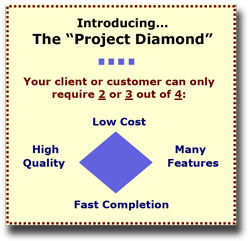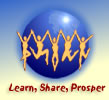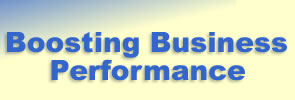Twelve Ways to Improve Your Estimating Accuracy (Part 2)
by Adele Sommers
Careful project estimating not only reduces the risks of projects running out of time, resources, or funding. It also enables you to recommend flexible alternatives, handle nebulous situations, and set sanity-saving boundaries around the effort to be performed. Part 1 of this series covered five tips for deriving meaningful predictions for your project activities:
1. Maintain an estimating and "actual hours" database.
2. Create project planning documents.
3. Perform a detailed task analysis.
4. Use a "complexity factor" to compare two sets of project tasks.
5. Use more than one method to arrive at an estimate.
This article (Part 2) offers three more tips to help you estimate more complicated or problematic situations.
6. Document caveats, constraints, and assumptions in your estimate.
 Especially when the project circumstances appear extremely dynamic or unpredictable, estimating the "unknown unknowns" can be particularly challenging. Especially when the project circumstances appear extremely dynamic or unpredictable, estimating the "unknown unknowns" can be particularly challenging.
The "knowns" represent only the tip of the iceberg. Do the remaining "unknowns" below the surface represent 20%, 50%, 100%, 200%, 400%, 800% or more of what is known?
My tips for using "triangulation" estimating, which involves at least three methods to converge on a set of numbers (in Part 1 of this series), wouldn't necessarily account for substantial unknowns, such as when project requirements are extremely vague, unstable, or poorly defined. You would need some kind of an "unknown unknown multiplier" to account for it all, which could be difficult to determine. Or, you could spend more time in the analysis phase researching or deriving better information.
When little time exists for analysis and estimating, however, collecting enough data may prove challenging. To counterbalance this disadvantage, you can plan to include caveats, constraints, and assumptions in your estimate to establish boundaries around your calculations.
Sample assumptions:
- "Reviews: a) A maximum of three internal review passes is assumed; any further reviews will be considered out of scope. b) All review comments will be returned to us no later than the scheduled due dates and will be summarized and reconciled by your Review Coordinator. c) Final review comments will be minor and will not introduce any substantial new changes. d) Reviewers and subject matter experts will be available to answer our questions as needed."
- "Out of scope tasks: If the specifications change after the project starts, out-of-scope activities will be itemized and billed at an hourly rate of $xxx. These tasks would include all additional design, development, review, testing, and administrative activities, for example."
 I refer to this technique as "the world is flat" approach. It's particularly helpful if you're being asked to "back into" a tiny budget or schedule, or there are many unknown factors. To summarize: I refer to this technique as "the world is flat" approach. It's particularly helpful if you're being asked to "back into" a tiny budget or schedule, or there are many unknown factors. To summarize:
- Given what you know today, you assume the "world is flat." You bound your estimate with your caveats, constraints, and assumptions.
- If you later discover that the "world is round" (there's much more to it than anyone thought), you could seek the additional time and funding needed to circumnavigate the globe.
- If that time and funding is unavailable, you could suggest a variety of remedies, such as the ones outlined in the tips below.
A valuable benefit of defining these conditions and expectations is that you are "calling the shots" to a certain extent. Rather than remaining at the mercy of the circumstances in which you might find yourself -- with lengthy delays in receiving answers from people, endless review cycles, or limitless requests for extra work -- you're outlining specific factors governing how you plan to operate. This is a very important technique to have in your estimating arsenal!
7. Propose adjusting the "project diamond" criteria.
When your estimates don't match the expectations or needs of your customers, you can propose making realistic adjustments. Avoid backing yourself into a corner by accepting an infeasible budget or schedule.
Initially, you either defined or received a set of
requirements for completing the project. Four types of criteria appear in the "project diamond," below (some of which
may have been implied rather than stated).
 It's not unusual for project
sponsors or clients to want: It's not unusual for project
sponsors or clients to want:
1)
Low cost and
2) Fast completion and
3) High quality and
4) Many features in the final project deliverables.
Although
it's understandable to want the greatest value
for the funding, usually it's possible to
achieve only two or three out of four of these
goals on a typical project. If both the budget and schedule are fixed, the tradeoffs would have to limit the quality, constrain
the features, or both.
For example, you can recommend reining in the scope by reducing the number or complexity of the features, and/or delivering more skeletal, less-polished quality, at least initially. Or, you could suggest delivering a pilot version that can be tested and refined later, rather than aiming to produce the complete result right away.
8. Consider alternative ways of performing the work.
If your estimate realistically shows too much to accomplish in the time available, try to determine where the bottlenecks (constraints) would exist in the workflow. Then brainstorm ways to relieve them, and include those results in your project estimates.
 For instance, you might be able to accelerate the flow of the work by relieving some performers of time-consuming tasks. Consider whether some tasks could occur in an "assembly-line mode," where certain people specialize in certain things. For instance, you might be able to accelerate the flow of the work by relieving some performers of time-consuming tasks. Consider whether some tasks could occur in an "assembly-line mode," where certain people specialize in certain things.
Let's say that highly skilled instructional designers would normally perform a large amount of editing and formatting as part of their roles. Yet they can easily become bogged down in these painstaking tasks and introduce a bottleneck in the workflow.
You might evaluate whether using specialized editors and formatters could remove that burden from the instructional designers' shoulders, leaving them to concentrate on what they do best. Making shifts in areas such as these could alleviate much of the pressure in the workflow.
In conclusion, including caveats, constraints, and assumptions in your estimates; realistically adjusting certain project criteria; and brainstorming alternative ways of performing work are effective options for handling challenging estimating scenarios. Next, Part 3 continues with yet another set of ideas.
Copyright 2011 Adele Sommers
|


